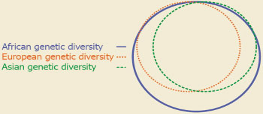 Starting with Lewontin (1972), studies have statistically apportioned variation in different genetic systems to different levels: among ‘races’ and within ‘races’ and smaller populations such as the Hopi, the Ainu, and the Irish. Lewontin collected data on blood group polymorphisms in different groups and races. He found that blood group variation between races statistically explains only about 6% of the total variation. These results show that if one is to adopt a racial paradigm, one must acknowledge that race will statistically explain only a small proportion of genetic variation. Moreover, this small variation is better explained by geographic distance (Templeton, 1998).
Starting with Lewontin (1972), studies have statistically apportioned variation in different genetic systems to different levels: among ‘races’ and within ‘races’ and smaller populations such as the Hopi, the Ainu, and the Irish. Lewontin collected data on blood group polymorphisms in different groups and races. He found that blood group variation between races statistically explains only about 6% of the total variation. These results show that if one is to adopt a racial paradigm, one must acknowledge that race will statistically explain only a small proportion of genetic variation. Moreover, this small variation is better explained by geographic distance (Templeton, 1998).
Yu et al. (2002) more recently compared a large sequence of DNA, 25 000 letters or base pairs long, of ten individuals from each of the three main ‘races’ typically used in medical studies: Asian, European, and African. They counted out the number of differences between any two individuals and found that the average number of differences between any two individuals from Africa was greater than the average number of differences between an African and a European or Asian. These results, shown below, support the understanding that there is greater genetic variation in Africa because of the increased evolutionary time humans have spent in Africa. Most startling perhaps is that Europeans and Asians, rather than being genetically separable, appear more accurately to be subsets of Africans. We truly are, it seems, all Africans.
In summary, human genetic variation is mostly local and greatest in Africa. Finally, what explains the amount of similarity and difference between any two groups is the geographic distance between groups. Like real estate, the important factors are location, location and location!




